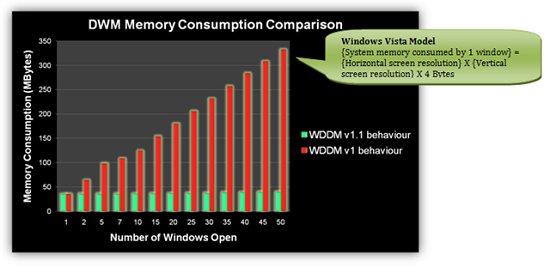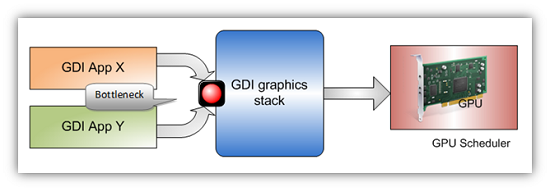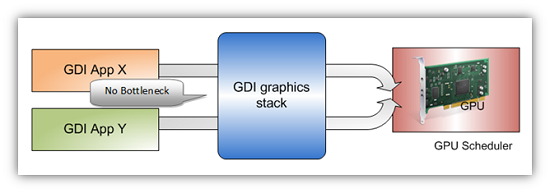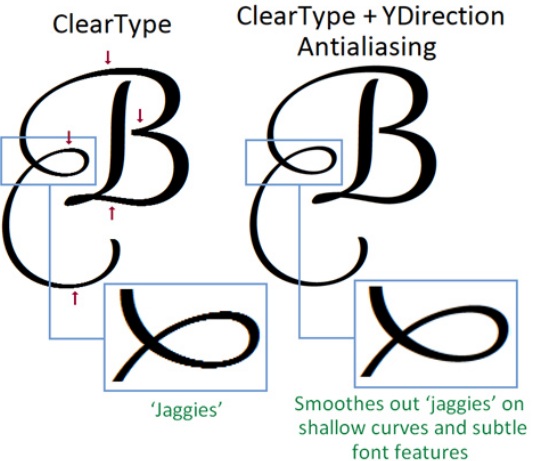Windows 7: Release Candidate 1 Preview
by Ryan Smith and Gary Key on May 5, 2009 11:00 PM EST- Posted in
- Systems
Getting Dirtier: Graphics
With the majority of the under the hood work focusing on graphics, there’s a lot to cover, so let’s get started.
Although it is being released for Vista too, Windows 7 marks the official introduction of Direct3D 11. As a superset of Direct3D 10.1, Direct3D 11 adds support for tessellation, multi-threaded rendering, and GPGPU abilities via the Compute Shader. We’ve already covered a great deal on Direct3D 11, so please see our introduction article on it for more details.
Next up we have the Windows Display Driver Model 1.1, which in turn is the lynchpin for several other graphics related features. WDDM 1.1 itself is not particularly impressive, but it’s what it allows that is. For all practical purposes, all we need to know about WDDM 1.1 is that it’s a minor revision of WDDM that requires DX10-class hardware (rather than DX9-class on WDDM 1.0) and as such allows the operating system additional features.
So what can you do with WDDM 1.1? For starters, you can significantly curtail memory usage for the Desktop Window Manager when it’s enabled for Aero. With the DWM enabled, every window is an uncompressed texture in order for it to be processed by the video card. The problem with this is that when it comes to windows drawn with Microsoft’s older GDI/GDI+ technology, the DWM needs two copies of the data – one on the video card for rendering purposes, and another copy in main memory for the DWM to work on. Because these textures are uncompressed, the amount of memory a single window takes is the product of its size, specifically: Width X Height x 4 bytes of color information.

Image courtesy Microsoft
Furthermore while a single window may not be too bad, additional windows compound this problem. In this case Microsoft lists the memory consumption of 15 1600x1200 windows at 109MB. This isn’t a problem for the video card, which has plenty of memory dedicated for the task, but for system memory it’s another issue since it’s eating into memory that could be used for something else. With WDDM 1.1, Microsoft has been able remove the copy of the texture from system memory and operate solely on the contents in video memory. As a result the memory consumption of Windows is immediately reduced, potentially by hundreds of megabytes.
What makes this even more interesting is how this was accomplished. With WinXP, GDI+ was partially accelerated, but this ability was lost to little fanfare when the DWM was introduced for Vista and thereby made GDI+ acceleration impossible, pushing all GDI work back to the CPU. This in turn is responsible for the need for a local copy of GDI and GDI+ windows and the increased memory usage of Vista, as reading data back from the video memory for the CPU to work on is too slow to be practical. The solution as it turns out is that by reintroducing GDI acceleration, the amount of read-backs can be minimized to the point that a local copy of the texture is no longer necessary. Now GDI isn’t completely accelerated, only the most common calls are, but this is enough that when the least common calls trigger a read-back, the performance hit is negligible.
This is one of the bigger changes in Windows to get memory consumption under control. The problem was particularly bad on netbooks and other systems with integrated graphics, as the video memory is the system memory, resulting in two copies of the texture being in the system memory (something such a machine probably has little of in the first place). The fact that this requires a DX10-class card with a WDDM 1.1 driver needs to be reinforced however – this won’t be of any help for systems with lesser GPUs, such as Atoms paired with the 945G chipset, as the GMA 950 GPU on that chipset is only DX9-class. NVIDIA, no doubt, is grinning from ear to ear on this one.
The other big trick as a result of WDDM 1.1 is that support for heterogeneous display drivers has returned. With WDDM 1.0 and its homogenous driver requirement, computers were limited to using video cards that would work with a single driver – in turn limiting a computer to video cards from a single vendor. With heterogeneous driver support, computers are once again free to use non-matching video cards, so long as they have a WDDM 1.1 driver. Besides that, this also is a boon for GPGPU use, as GPUs continue to interface with Windows via WDDM regardless of whether they’re actually displaying something or not. For example, this would allow NVIDIA to sell video cards as GPGPU processors to ATI owners, and vice versa.
WDDM 1.1 also brings a few lesser features to Windows 7. The DWM can now run in DX10 mode and new controls are introduced for aspect ratio scaling and controlling monitor modes.
Moving on from WDDM 1.1, Microsoft has also introduced some changes to GDI that do not require new display drivers. Along with requiring a local copy of window textures, the GDI stack was locked so that only a single GDI application could access it at a time. The GDI stack has been rebuilt so that the lock is more or less removed. Multiple GDI applications can now issue commands to it at the same time, and this is all pushed off to the video card to be its problem.


Images courtesy Microsoft
Unfortunately Microsoft has not provided us with any examples of this in action, so we’re not sure just what the real-world benefit is.
Next up, more DRM. Although we’re not entirely sure what has been changed, Microsoft has told us that they have made some changes with respect to DRM and GPU acceleration. Previously some applications playing DRMed content needed to switch to overlay mode to ensure the content was protected the entire way through. Likely this is a new low-level API for such functionality; Microsoft’s notes mention a standardized API for CPU to GPU encryption.
Last but not least, we have two new high-level graphics APIs in Windows 7. The first is Direct2D, the successor to GDI and a replacement for some Direct3D functionality. Like Direct3D, Direct2D is a fully hardware accelerated API, but it’s only for 2D operations. When Microsoft deprecated DirectDraw, the intention was for developers to use Direct3D for all of their 2D needs, but this never quite worked out as well as they intended. So now we have Direct2D, which gives developers a dedicated 2D API once again, along with a clear replacement for GDI.
Also introduced is an API specifically for text, DirectWrite. Where Direct2D works on 2D primitives, DirectWrite is responsible for the hardware anti-aliasing of text. NVIDIA sent us some documentation on the matter, and apparently the anti-aliasing method used (YDirection Antialiasing) can provide even better smoothing than ClearType can alone. It does not sound like any Windows components are currently using DirectWrite however.

Hardware font anti-aliasing in action. Image courtesy NVIDIA
We should note that while the “Direct” name implies these APIs are a part of DirectX, all of the material we have on the matter only mentions Windows 7. They may not be part of DirectX, in which case they would not be added to Vista as part of DirectX 11.










121 Comments
View All Comments
Ryan Smith - Thursday, May 7, 2009 - link
Actually, it has both of those features, although as the article was running long and I didn't consider them important I didn't mention them. It can defrag drives simultaneously. Scheduling has been in there since at least Vista.strikeback03 - Thursday, May 7, 2009 - link
I was able to schedule weekly defrags back in Win2000 on my old laptopleexgx - Wednesday, May 6, 2009 - link
it can if you use command line on win7 (emm i think it does loet you defrag more then one disk at the same time in the GUI, got no power for laptop so cant find out yet)Pirks - Wednesday, May 6, 2009 - link
http://www.f-secure.com/weblog/archives/00001675.h...">http://www.f-secure.com/weblog/archives/00001675.h...leexgx - Wednesday, May 6, 2009 - link
Hide extensions for known file types, yes every PC i am on i untick that option, its So unsafe its unrealwith windows 7 extensions should Not be hidden be it any verson of windows with vista pressing F2 or rename only selects the name now not all of the file name like XP and lower does so harder to lose the extension
Pirks - Wednesday, May 6, 2009 - link
Yeah, I agree that extensions should NOT be hidden BY DEFAULT. Unfortunately they are hidden. So, Win 7 is still a virus heaven _by default_!JarredWalton - Wednesday, May 6, 2009 - link
Hiding extensions doesn't make it a "virus heaven"; it just makes it possible for Trojan horses to trick stupid users a bit easier. How does that malware.txt.exe file get to the PC in the first place? By some user being stupid. If extensions are hidden, then why is that file called "malware.txt" rather than just "malware"? Oh yes: because it's trying to trick you by not doing the same thing as every other icon, so it's already a red flag (which admittedly most computer users are not smart enough to notice).For technical people, the extensions mean something - I know I always show them - but for most computer users the fact that an icon says "EXE", "SCR", "COM", "CMD", or anything else as the extension means very little. If you don't *know* what an icon is, you shouldn't click it. Simple! But sadly most computer users are not smart enough to know that.
B3an - Friday, May 8, 2009 - link
That comment was posted by Pirks. Possibly the biggest apple fanboy ever. I'm not sure i've seen a comment of his on DailyTech that hasn't been rated down. Dont feed the troll.leexgx - Wednesday, May 6, 2009 - link
network tests need to be done not the same as XPplease open winamp, WMP or teamspeak play something and then do the gigabit network test thay must of fixed the 10MB/s cap problem on Win7 when playing sound (have to mess with vista reg to remove the MMS limiter), none raid to none raid pcs shouuld be doing harddisk speeds acroess the network {70-90mb/s ish,}raid to raid or SSD should be 120MB/s about on the network
Ryan Smith - Thursday, May 7, 2009 - link
It's a time issue; we didn't have a chance to work that it. It has been noted, and I'll make sure that gets in the next W7 article.